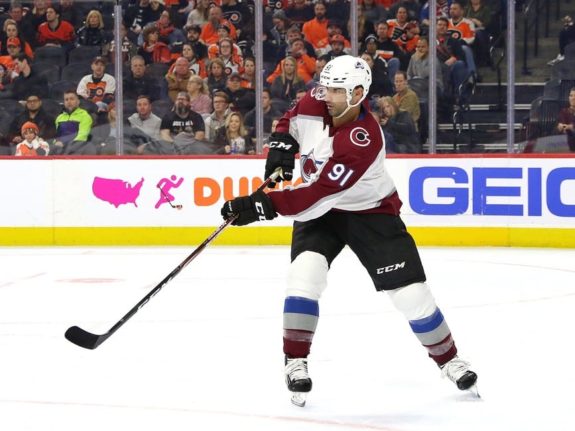Apart from Brad Marchand and Tom Wilson, few players are as polarizing as the Colorado Avalanche’s Nazem Kadri, who once again stirred up controversy in Game 3 of the team’s second-round series against the St. Louis Blues. With a loose puck up for grabs in front of the Blues’ net, Kadri and Blues defenseman Calle Rosen barrelled towards the goal, with a series-ending injury to goaltender Jordan Binnington the unfortunate result of the ensuing collision in the crease. Each team understandably took opposing views of the incident, with Kadri’s spotted disciplinary history a significant factor in those outside the Avalanche organization unwilling to give him the benefit of the doubt.
Still, with all the attention being concentrated on the aforementioned incident, it’s easy to overlook the fact that Kadri also tallied two points in the Avalanche’s 5-2 win, giving them a 2-1 series lead ahead of a pivotal Game 4. That production is a frustrating aspect of any Kadri discussion. The skill and talent are evident, but he so frequently toes the line that they become secondary in the analysis of his impact on his team’s success. Let’s dig into how Game 3 was a microcosm of the Kadri experience and then discuss how that is exactly how he wants to make his mark.
Kadri Has a Messy Disciplinary History
Kadri’s negative reputation stems from his time with the Toronto Maple Leafs when he was suspended in two straight playoff series for poorly-timed hits where the emotion of the occasion got the best of him. As the Maple Leafs ended up bowing out in seven games in both series, Kadri’s absence loomed large in a pair of those close defeats. His lack of discipline contributed to his trade to the Avalanche, but his tendency to play on the edge followed him to his new home in Colorado.

In last season’s first-round series with the Blues, Kadri was suspended for a hit to the head of defenseman Justin Faulk, leaving the Avalanche shorthanded in their second-round battle with the Vegas Golden Knights. It’s this history that makes the Binnington incident particularly controversial in the eyes of Blues fans, and indicative of his continued flouting of the rules. His fiery attitude allows him to be a real menace to opponents when channeled in an appropriate manner, but it’s been a tricky beast to tame throughout his career. On top of the suspensions, he’s been the 68th most penalized skater in the NHL since making his NHL debut in the 2009-10 season, accruing 589 penalty minutes in 739 games.
Even so, his performance during the 2021-22 season suggests that perhaps he’s turned the corner, and could finally be the impact player he’s shown flashes of becoming over his NHL tenure.
Kadri Experienced Offensive Evolution in 2021-22 Regular Season
To say that Kadri’s 2021-22 campaign was unexpected is putting it lightly. The 31-year-old center posted career-highs in nearly every major statistical category, with his 59 assists and 87 points setting new benchmarks. Injuries and COVID-related absences to the Avalanche’s stars in Nathan MacKinnon and Gabriel Landeskog, among others, pushed him to the forefront of the team’s attacking gameplan, and he capitalized on the expanded opportunity. After winning the fan vote for the Last Men In, Kadri joined his more heralded Avalanche teammates in representing the Central Division in the 2022 All-Star Game. The league-wide recognition capped off a thoroughly impressive campaign, and it looked as though he finally had funnelled his energy into becoming a bonafide two-way star.
Related: 4 Reasons the Avalanche Will Win the 2022 Stanley Cup
A good chunk of his production came from increased usage on the Avalanche’s primary power-play unit, where Kadri played a career-high 275 minutes. For the 13-year-veteran, 29 of his 87 points (eight goals and 21 assists) came with the man-advantage, but his per-60-minute rates at even strength showed that he wasn’t just benefitting from more favourable deployment. His goals (third), assists (first), and primary assists (second) rates were among the highest of his career, but he didn’t depend on a sky-high shooting percentage (SH%) to post such numbers. His 11.3% SH% in all situations was only the seventh-highest of his career, and his on-ice mark (OiSH%) which accounts for his linemates’ finishing, was two percentage points lower than his previous best.
The Avalanche and head coach Jared Bednar clearly trust Kadri to create offense, and he took on an increased role with ease while not relying on unsustainable percentages to boost his point totals. Whether his play has truly evolved or if his production is a result of the contract-year phenomenon, he looks like a different player. Unfortunately for this iteration of the Avalanche, the postseason is all that matters. Regular-season excellence is one thing, but overcoming the trials and tribulations of the playoffs is the goal, especially with MacKinnon’s contract extension looming after next season.
Kadri Leading Avalanche in Several Statistical Playoff Categories
After a relatively tame first-round series in which Kadri only tallied three points in four games against the Nashville Predators, he’s become more involved against the Blues, likely feeding off of the increased physicality in the series. Over the first three games, he is tied for second on the team in scoring (three points), second in shots (10), and leads the team in scoring chances (14) and individual expected goals (1.24 iXG) while winning over 53% of his faceoffs. With St. Louis keying in on the Avalanche’s top line, Kadri must produce for Colorado to surpass the Blues and advance to the Western Conference Final for the first time since 2002.

Kadri’s play at 5v5 has been strong outside of his point production. With him on the ice, the Avalanche have controlled 68.6% of shot attempts (CF%), 64.4% of expected goals (xGF%) and 69.6% of scoring chances (SCF%), with all three marks either first or second on the team in the series. Over the course of the first two rounds, only MacKinnon has taken shots and completed primary shot assists more frequently than Kadri among Avalanche skaters. Yet, he’s been Colorado’s most dangerous forward in transition, generating 6.3 zone entries per-60 leading to scoring chances.
It just goes to show that when Kadri is engaged and pushes the distractions to the outside, he is one of the best support players in the league. However, with a target on his back going into Game 4 and beyond, maintaining his focus will be difficult.
Avalanche’s Stanley Cup Hopes Rest on Kadri Keeping Emotions in Check
As Kadri’s unexpected regular-season eruption has shown, the Avalanche are a different team when he is engaged and providing a steady stream of secondary scoring behind the team’s offensive superstars. His feisty two-way game is tailor-made for the postseason, but he can’t make an impact from the sidelines. The Blues’ physical response to the Game 3 incident is sure to be notable, but he must refrain from getting roped into tussles after the whistle. He has the chance to prove to the rest of the league that he has matured and is worthy of what could be an immense contract in free agency. If the Avalanche are to break their recent second-round curse and end a 21-year Stanely Cup drought, he must keep his eyes on the prize – which is easier said than done considering his history.
Data courtesy of All Three Zones, Natural Stat Trick, and the NHL.